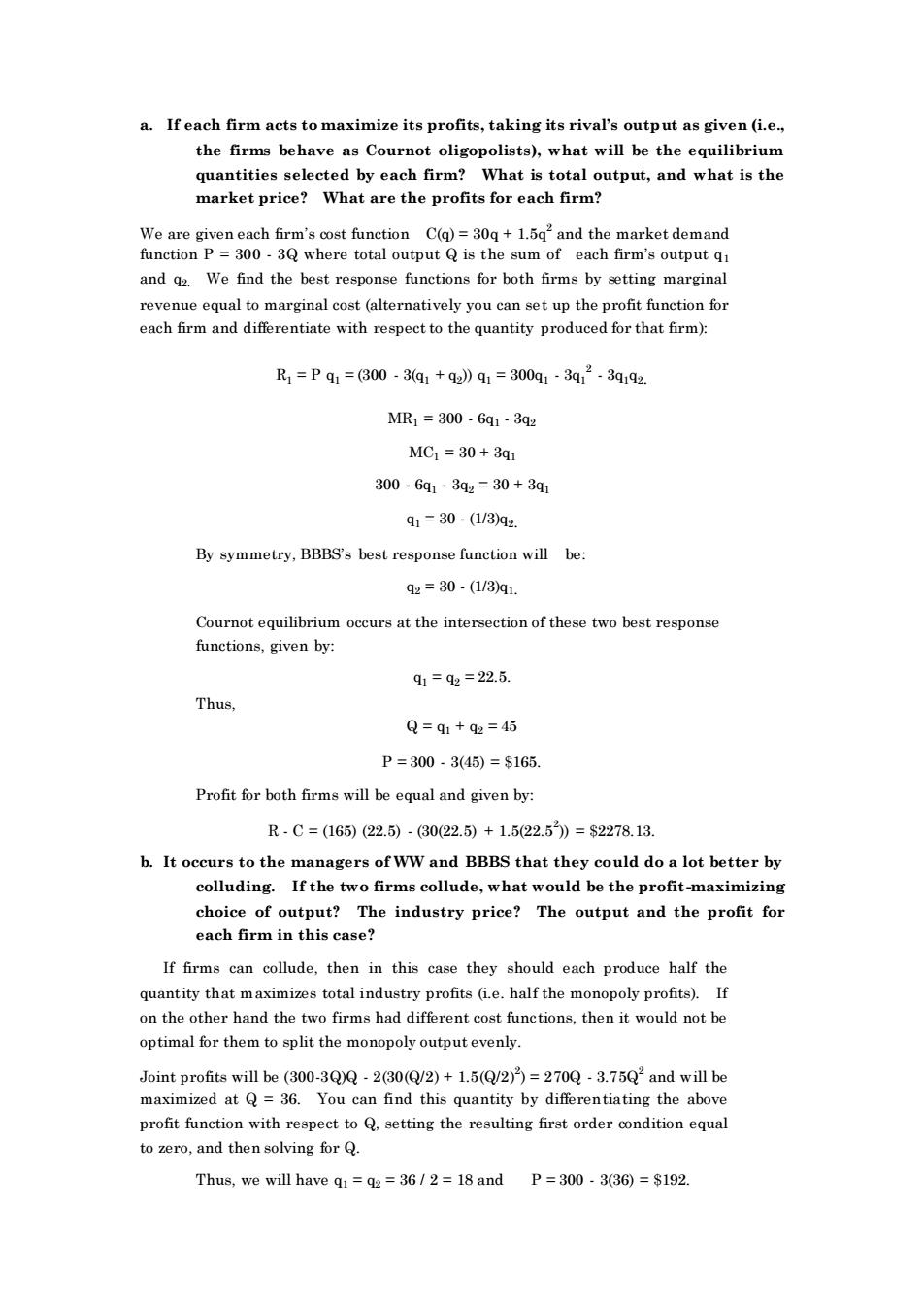正在加载图片...

a.If each firm acts to maximize its profits,taking its rival's output as given (i.e. the firms behave as Cournot oligopolists),what will be the equilibrium quantities ed by each firm? What is total output,and what is the market price? What are the profits for each firm? We are given each firm's cost function C(q=30q+1.5qand the market demand function P=300-3Q where total output Q is the sum of each firm's output qi and qz.We find the best response functions for both firms by setting marginal revenue equal to marginal cos(alternatively you can setup the profit function for each firm and differe tiate with respeet to the quantity produced for that firm) R1=Pq1=(00-3(q1+q》91=300q1-3q12.3q192 MR1=300.613e MC=30+341 300.6q1-34=30+39 q1=30.(13)4. By symmetry,BBBS's best response function will be: q2=30-(1/3)q1 Cournot equilibrium occurs at the intersection of these two best response functions,given by: q1=2=22.5. Thus, Q=q1+q=45 P=300.3(45)=$165 Profit for both firms will be equal and given by: R.C=(165)(22.5)-(30(22.5)+1.522.5)=$2278.13. b.It occurs to the managers of WW and BBBS that they could do a lot better by colluding.If the two firms collude,what would be the profit-maximizing choice of output?The industry price?The output and the profit for each firm in this case? If firms can collude,then in this case they should each produce half the quantity that industry the)If on the other hand the two firms had different cost functions,then it would not be optimal for them to split the monopoly output evenly. Joint profits will be (300-3Q)Q-2(30(Q/2)+1.5(Q/2))=270Q-3.75Q"and will be maximized at Q=36.You can find this quantity by differentiating the above profit function with respect to Q.setting the resulting first order condition equal to zero,and then solving for Q. Thus,we will have q1=q2 36/2=18 and P=300-3(36)=$192. a. If each firm acts to maximize its profits, taking its rival’s output as given (i.e., the firms behave as Cournot oligopolists), what will be the equilibrium quantities selected by each firm? What is total output, and what is the market price? What are the profits for each firm? We are given each firm’s cost function C(q) = 30q + 1.5q2 and the market demand function P = 300 - 3Q where total output Q is the sum of each firm’s output q1 and q2. We find the best response functions for both firms by setting marginal revenue equal to marginal cost (alternatively you can set up the profit function for each firm and differentiate with respect to the quantity produced for that firm): R1 = P q1 = (300 - 3(q1 + q2 )) q1 = 300q1 - 3q1 2 - 3q1q2. MR1 = 300 - 6q1 - 3q2 MC1 = 30 + 3q1 300 - 6q1 - 3q2 = 30 + 3q1 q1 = 30 - (1/3)q2. By symmetry, BBBS’s best response function will be: q2 = 30 - (1/3)q1. Cournot equilibrium occurs at the intersection of these two best response functions, given by: q1 = q2 = 22.5. Thus, Q = q1 + q2 = 45 P = 300 - 3(45) = $165. Profit for both firms will be equal and given by: R - C = (165) (22.5) - (30(22.5) + 1.5(22.52 )) = $2278.13. b. It occurs to the managers of WW and BBBS that they could do a lot better by colluding. If the two firms collude, what would be the profit -maximizing choice of output? The industry price? The output and the profit for each firm in this case? If firms can collude, then in this case they should each produce half the quantity that maximizes total industry profits (i.e. half the monopoly profits). If on the other hand the two firms had different cost functions, then it would not be optimal for them to split the monopoly output evenly. Joint profits will be (300-3Q)Q - 2(30(Q/2) + 1.5(Q/2)2 ) = 270Q - 3.75Q2 and will be maximized at Q = 36. You can find this quantity by differentiating the above profit function with respect to Q, setting the resulting first order condition equal to zero, and then solving for Q. Thus, we will have q1 = q2 = 36 / 2 = 18 and P = 300 - 3(36) = $192